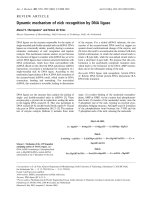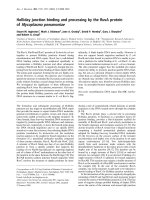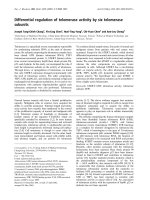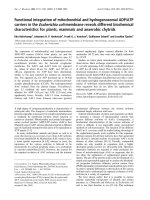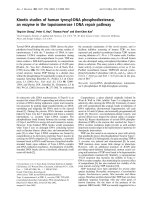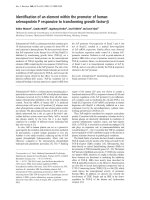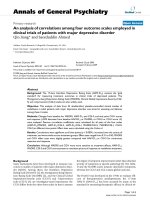Báo cáo y học: "Ethnomedical survey of plants used by the Orang Asli in Kampung Bawong, Perak, West Malaysia" docx
Bạn đang xem bản rút gọn của tài liệu. Xem và tải ngay bản đầy đủ của tài liệu tại đây (689.98 KB, 6 trang )
RESEARC H Open Access
Ethnomedical survey of plants used by the Orang
Asli in Kampung Bawong, Perak, West Malaysia
Anbu Jeba Sunilson John Samuel
1,2*
, Anandarajagopal Kalusalingam
1
, Dinesh Kumar Chellappan
1
,
Rejitha Gopinath
1
, Suraj Radhamani
1
, Hj Azman Husain
3
, Vignesh Muruganandham
1
, Proom Promwichit
1
Abstract
Background: A qualitative ethnomedical survey was carried out among a local Orang Asli tribe to gather
information on the use of medicinal plants in the region of Kampung Bawong, Perak of West Malaysia in order to
evaluate the potential medicinal uses of local plants used in curing different diseases and illnesses.
Methods: Sixteen informants ranging in age from 35 to 65 years were interviewed. A total of 62 species of plants
used by Orang Asli are described in this study based on field surveys and direct face to face communication. These
plants belonged to 36 families and are used to treat a wide range of discomforts and diseases.
Results: The results of this study showed that majority of the Orang Asli, of Kampung Bawong are still dependent
on local plants as their primary source of medication. As the first ethnomedical study in this area, publishing this
work is expected to open up more studies to identify and assess the pharmacological and toxicological action of
the plants from this region.
Conclusions: Preservation and recording of ethnobotanical and ethnomedical uses of traditiona l medicinal plants
is an indispensable obligation for sustaining the medicinal and cultural resource of mankind. Extensive research on
such traditional plants is of prime importance to scientifically validate their ethnomedical claims.
Background
The study of tribal knowledge of plants is an imperative
facet of ethnomedical research. People healed them-
selves with traditional herbal medicines and ancient
remedies from time immemorial [1,2]. Human beings
have found remedies within their habitat, and have
adopted different strategies depending upon the cli-
matic, phyto-geographic and faunal characteristics, as
well as upon the peculiar culture and socio-structural
typologies [3]. Most of such information is passed on to
the f ollowing generations by traditional healers through
oral communication and discipleship practice [4]. More-
over, the World Health Organization (WHO) has
reported that about 80% of the world population relies
on traditional medicine to cure ail ments [5,6]. Plants
play a major role in the treatment of diseases and still
remain the foremost alternative for a large majority of
people [7-9]. This knowledge, if wisely utilized, could
draw out promising herbal leads [10].
Perak, (Fig. 1) (5.02 N latitude and 101.08 E longi-
tude), in Malaysia is one such area where traditional
healing systems are still in practice among the local
natives, especially the ‘Orang Asli’ tribes. Till date, no
literature is availabl e regarding the ethnomedical knowl-
edge of this area, though there are ethnomedic al reports
on few other regions in Malaysia [11-13]. The ‘Orang
Asli’, which means ‘first people’, are considered to be
the original natives of peninsular Malaysia. There are
about 150, 000 Orang Asli people of which 60% still live
in the rain forests. There are 19 sub-groups among
them, like Semai, Temiar, Lanoh and Jah Hut to name a
few [14]. Many of the Orang Asli practitioners use local
plant parts and plant juices to cure ailments and this
practice is still in use [15]. Yet, little attention has been
given to their traditional expertise to incorporate their
knowledge in modern medicine. This study is an
attempt to identify and document the use of traditional
medicine among the local Orang Asli along the Kam-
pung Bawong region in Perak.
* Correspondence:
1
School of Pharmacy, Masterskill University College of Health Sciences,
Taman Kemacahaya 11, Jalan Kemacahaya, Cheras, Selangor, Malaysia
Samuel et al. Journal of Ethnobiology and Ethnomedicine 2010, 6:5
/>JOURNAL OF ETHNOBIOLOGY
AND ETHNOMEDICINE
© 2010 Samuel et al; licensee BioMed Central Ltd. Thi s is an Open Access article distributed under the terms of the Creative Commons
Attribution License (http://creativecommons.o rg/licenses/by/2.0), w hich permits unrestricted use, di stribution, and reprod uction in
any medium, provided the original work is properly cited.
Methods
Regular field trips were made to the selected tribal local-
ities in different seasons of the year 2008, conducted in
rural area located in Kampung Bawong. The authors
worked with a specific tribe of Orang asli called the
‘semang’ who fall under the group ‘neg rit o’ (Fig. 2, 3).
Sixteen informants were involved in the inter views. All
informants were in the age group of 35 to 65 years. All
informants were male. 3 of them were practicing herbal-
ists, and the rest 13 were indiv iduals who gained knowl-
edge on medicinal uses of plant s from their parents and
relatives who were historically using the plants with pro-
mising results. Interviews were conducted i n a local dia-
lect of Malay language. Interviewing individual
informant was of fundamental importance to assure the
reliability of the gathered information. Individual inter-
views were conducted with 7 informants (3 herbalists
and 4 individual informants) and one group discussion
involving the remai ning 9 informants was also con-
ducted. The interviews were built on trust with a com-
monaspirationtoimprovethehealthsituationinthe
country and to conserve and increase the knowledge on
Figure 1 Map of the Kampung Bawong region where the ethnomedical field survey was conducted.
Samuel et al. Journal of Ethnobiology and Ethnomedicine 2010, 6:5
/>Page 2 of 6
medicinal plants. The information was collected in the
local dialec t of Malay language. Special concern was
taken in collecting information to steer clear of any
unoriginal information by sources such as books and
magazines were rejected. Some informants were repeat-
edly merited during field trips to confirm the informa-
tion provided by them previously. Interpretation and
translation of the information received into technical or
medicinal terms was cautiously avoided during the inter-
views so as to obtain a genuine picture of customs and
uses. All the plants were identified by Dr. Encik Sani,
Botanist, Department of Botany, University Kebangsan
Malaysia, Selangor, Malaysia. Voucher herbarium speci-
mens were prepared and deposited in the herbarium of
Department of Pharmacognosy, Masterskill University
College of Health Sciences, Selangor, Malaysia.
Results and Discussion
The present ethnomedical field survey indicated that
there are 62 medicinal plant species belonging to a tota l
of 36 families which are used in Kampung Bawong
(Table 1). Most of these species grow in the wild natu-
rally and their medicinal properties are crucial in tradi-
tional medicine of the Orang Asli. Majority of the
species reported in this paper are widely known
throughout peninsular Malaysia and are employed for a
large number of medical conditions.
The plants were often used by most of the informants
more or less for the same purpose, and with only slight
variations in recipes. The plants are usually collected
from wild. All species were ea sily recognized by the
informants with their respective local Malay dialect
names. Some of the plants commonly used belong to
Figure 2 An Orang asli crossing the river on their own wooden boat (perahuk) for fishing and hunting.
Figure 3 An Orang asli using blow pipe made up of sewor bamboo for hunting.
Samuel et al. Journal of Ethnobiology and Ethnomedicine 2010, 6:5
/>Page 3 of 6
Table 1 Plants used by Orang Asli in Kampung Bawong, Perak of West Malaysia
Botanical
Family
Botanical name Local Malay
Dialect
Part Used Medicinal Uses
Acanthaceae Barleria lupulina Lindl Penawar
Seribu Bisa
Leaves Fresh leaves are used to remove warts
Barleria prionitis Linn. Hempedu
landak
Leaves Leaves are crushed and make into paste and applied over the inflamed
area
Dipteracanthus repens (L.)
Hassk.
Deras malam Leaves Powder of dried leaves is mixed in warm water and drink to remove
kidney stones
Eranthemum borneense
Hook f.
Sangsangkaruk Leaves Paste of leaves is applied to treat muscle cramps
Strobilanthes crispus
Blume.
Bayam karang Leaves Fresh leaves are masticated and swallowed as such to enhance the
immune system
Annonaceae Annona muricata Linn. Durian
Makkah
Leaves Leaves are used to treat to kill all types of lice
Fruits Fruit juice is used to treat Stomach pain and hypertension
Uvaria sorsogonensis C.
Presl.
Segombong Leaves Decoction of the leaves is used to cure stomach ulcer
Araliaceae Arthrophyllum
diversifolium Blume.
Ondolus Roots Roots are boiled with water and drink to relieve body pain
Asteraceae Eupatorium odoratum
Linn.
Pokok
kapalterbang
Leaves Decoction of leaves is used as diuretic
Asclepiadaceae Hoya coronaria Blume. Takop Leaves Crushed leaves are applied to cure cuts and wounds
Bombacaceae Bombax ceiba Linn. Kapok Leaves Leaves are soaked into water and the decoction is taken for bath to treat
body pain
Caesalpiniaceae Caesalpinia crista Linn. Gorek Seeds Seeds are crushed and mixed with sambal for appetite
Caprifoliaceae Sambucus javanica
Reinw. ex Blume
Kerak nasi Leaves Crushed the leaves with water and applied on inflamed parts to reduce
pain and inflammation
Clusiaceae Garcinia mangostana
Linn.
Mangusta Fruit Fresh juice is used as nutrient drink
Pericarp Dried powder is used to heal the open wounds
Compositae Artemisia argyi Levi. et
Vant.
Ulam mak
wan
Leaves Fresh leaves are chewed in case of cough
Gynura procumbens
(Lour.) Merr.
Daun dewa Leaves Fresh leaves are used for to control blood glucose level
Connaraceae Agelaea macrophylla
(Zoll.) Leenh.
Akar pinang
kutai
Leaves The paste of leaves is used to treat acne
Cnestis platantha Griff. Binsangut Leaves Young leaves are warmed and applied to treat high fever
Euphorbiaceae Croton caudatus Geisel Tapasan
komudi
Roots Roots are boiled and the infusion is used as Nutrition.
Euphorbia tirucalli Linn. Mentulang Latex Latex is used to remove warts
Jatropha curcas Linn. Jarak Belanda Leaves Paste of young leaf is applied to treat cuts and wounds
Roots Roots are boiled and infusion is taken to treat diarrhea
Phyllanthus niruri Linn. Dukung Anak Whole
plant
Decoction of whole plant is used to treat jaundice
Fabaceae
Parkia speciosa Hassk. Petai Seeds Fresh seeds are cooked and used to treat kidney disorders
Gnetaceae Gnetum leptostachyum
Blume.
Langod-
langod
Whole
plant
The plant was boiled in water and drink for relieve fever and flu
Lauraceae Cassytha filiformis Linn. Cemara Puteri Whole
Plant
Concoction used for the treatment of impotency
Leguminosae Archidendron ellipticum
Blume.
Bulinat Leaves Leaves are used to kill lice
Bauhinia semibifida Roxb. Daup-daup Roots Roots are boiled and the infusion is used to treat fatigue
Peltophorum
pterocarpum (DC) K.
Heyne
Cugah Barks Powdered barks are applied on the affected area to treat psoriasis
Samuel et al. Journal of Ethnobiology and Ethnomedicine 2010, 6:5
/>Page 4 of 6
Table 1: Plants used by Orang Asli in Kampung Bawong, Perak of West Malaysia (Continued)
Pongammia pinnata Linn. Kacang kayu
laut
Leaves and
Seeds
Fresh leaves and seeds are crushed and applied to repel insects
Barks Decoction of barks is used to kill intestinal worms
Loranthaceae Dendrophoetoe constricta
Dans.
Salidan Leaves Paste of leaves is applied to treat headache
Malvaceae Abutilon indicum Linn. Kembang
Lohor
Leaves Poultice in the treatment of fever
Hibiscus rosa sinensis
Linn.
Bunga Raya Root barks Root barks is soaked in water for overnight and taken in empty stomach
to treat ulcer
Hibiscus tiliaceus Linn. Daun baru Barks Dried powder is used to cure all types of sexually transmitted diseases
Meliaceae Aglaia odorata Lour. Pacar cina Flowers An infusion is used to reduce fever
Trichilia trijuga Roxb Kayu kaling Barks Fresh barks are crushed and the juice is applied to cure cuts and
wounds
Menispermaceae Tinospora crispa Linn. Pokok
patawali
Stem Decoction of the stem is used to treat diabetes
Myrsinaceae Ardisia colorata Roxb. Pacar inai Leaves Decoction of the leaves is used to cure viral infections such as herpes
zoster, measles
Ardisia crenata Sims. Mata Ayam Whole
Plant
The crushed juice is used to treat earaches and fever
Myrtaceae Syzygium cerina Hend. Bagu Roots Roots are boiled with water and drink as an energizer
Syzygium samarangenese
Blume.
Red Jambu Leaves Leaves are used to treat skin infections
Oleaceae Jasminum sambac (L.) Ait Kampupot Leaves Young leaves are soaked in cold water and drink to treat gallstones
Roots Roots are boiled and the infusion is taken to treat diabetes mellitus
Oxalidaceae Averrhoa bilimbi Linn. Tulod-ulod Leaves A cocktail of the leaves along with the fruit is used to treat Syphilis
Orchidaceae Bulbophyllum mutabile
(Bl.) Lindl
Tatau Leaves Leaves are boiled and the decoction is used to treat fever
Poaeceae Imperata cylindrica (L.)
Beauv.
Lalang Whole
plant
Dried powdered plant is applied over the wounds to prevent microbial
infections
Portulacaceae Talinum triangulare (Jacq.)
Willd.
Akar singsum Flowers Powder of dried flowers is mixed with tea and drink to treat asthma
Rubiaceae Morinda citrifolia Linn. Bingkudu Fruits Fruits juice is used to treat Jaundice
Oldenlandia diffusa
(Willd.) Roxb.
Siku-siku Leaves Juice of fresh leaves is used as Sedative
Ruscaceae Sansevieria trifasciatai
Prain.
Snake plant Leaves 2 or 3 drops of fresh juice is instilled into ear to reduce pain and
inflammation
Sapotaceae Planchonella obovata (R.
Br.) Pierre
Gombirat Leaves A paste of the leaves is applied on the forehead to relieve headache
Schizaeaceae Lygodium circinnatum
Burm.
Ribu-ribu Leaves Infusion of leaves is used to cure eye infection
Simaroubaceae Eurycoma longifolia Jack. Tongkat ali Roots Decoction of roots with tea is used as sexual stimulant
Solanaceae Solanum nigrum Linn Terong
meranti
Fruits and
Leaves
Fruits and leaves are chewed to treat upper respiratory tract infections
Umbeliferae Centella asiatica Linn. Pegaga Leaves Leaves are boiled and the infusion is used for mother who just give birth
Verbenaceae Lantana camara Linn. Bunga Tahi
Ayam
Leaves Leaves are boiled with water and spray to repel insects
Stachytarpheta
jamaicensis Linn. Vahl.
Bunga malam Whole
plant
The whole plant was crushed with water and applied on the injured
ligament to relieve the pain and inflammation
Zingiberaceae Curcuma petiolata Roxb. Temu Puteri Rhizomes Juice is used to cure stomach ache
Languas conchigera
Burkill
Lengkuas Kecil Rhizomes Minced rhizomes are used for digestion
Kaempferia galanga Linn. Cekur Rhizomes Juice of the rhizomes is used for the treatment of stomach pains and
coughs
Zingiber ottensii Valeton Kunyit Terus
Hitam
Rhizomes The juice of the rhizomes is used to cure all types of bacterial infections
Samuel et al. Journal of Ethnobiology and Ethnomedicine 2010, 6:5
/>Page 5 of 6
the family Euphorbiaceae, Acanthaceae, Leguminosae,
Zingiberaceae and Mal vaceae. Most of these plants we re
used to relieve pain and to cure wound. Certain plants
have specific use such as Strobilanthes crispus Blume.,
which is used to enhance the immune system and Eury-
coma longifolia Jack., roots used as aphrodisiac. Results
of this survey indicate that theseplantswereinusefor
a long time by the ethnic group.
Conclusions
This current ethnomedical field survey carried out among
the Orang Asli living in the Kampung Bawong regio n of
Perak, Malaysia reveals that many medicinal plants are still
broadly used by the population in the area where the study
was conducted for treating various diseases and ailments.
It is believed that there are more than 100 species of tradi-
tional herbal medicines found in this region. Since many
plant species are indicated as potential resource for treat-
ing various diseases, this should encourage further
research in ethnomedicine. The informants’ consensus in
the treatment of the main reported diseases is quite high,
giving more validity to the plants as a traditional remedy.
The current data will expand the genetic resources
obtainableintheareaofresearchandsignifyapotential
source of natural products for treating various diseases.
The preservation of these plant species is the gateway
toward developing efficacious remedies f or treating dis-
eases. Due to lack of knowledge and interest among the
younger generations, some of the traditional medical infor-
mation was buried together with the previous generations.
This implies that the local government and village authori-
ties need to act fast to conserve the ethnomedical knowl-
edge of Orang Asli in the village Kampung Bawong, and
the medicinal plants require preservation in addition to
the ethnobotanical and ethnomedical knowledge record-
ing. The preservation of these herbs along with the tradi-
tional knowledge of how to use them is an indispensable
obligation for sustaining traditional medicine as a medic-
inal and cultural resource. Thus a future extensive
research of these plants in this locality is recommended to
identify and assess their ethnomedical claim.
Acknowledgements
The authors are thankful to the management, Dato’ Prof. Dr. Ishak Bin Tambi
Kechik, Vice-Chancellor and Dato’ Edmund Santhara, GCEO, Masterskill
University College of Health Sciences, Malaysia, for their funding, continuous
encouragement and support. The authors also acknowledge the efforts of
Dr. Encik Sani, Botanist, Department of Botany, University Kebangsan
Malaysia, Selangor, Malaysia and the Orang asli tribes of Kampung Bawong
for their dedicated support.
Author details
1
School of Pharmacy, Masterskill University College of Health Sciences,
Taman Kemacahaya 11, Jalan Kemacahaya, Cheras, Selangor, Malaysia.
2
Honorary Associate, School of Pharmacy, La Trobe University, Bendi go,
Victoria 3552, Australia.
3
School of Biomedicine and Health, Masterskill
University College of Health Sciences, Taman Kemacahaya 11, Jalan
Kemacahaya, Cheras, Selangor, Malaysia.
Authors’ contributions
All the authors interviewed Orang asli people and identified all plant
material described. JAJS developed the concept, designed and lead the
project and also reviewed the manuscript. KA, GR, HAH, RS, MV, DKC and PP
conducted the survey about the plants used by Orang Asli. KA, DKC and GR
were also involved in the preparation of manuscript. HAH and PP were also
involved in the verification of collected plants data for their vernacular
name. SR, DKC and MV were also involved in reviewing the manuscript. All
authors read and approved the final manuscript.
Competing interests
The authors declare that they have no competing interests.
Received: 10 July 2009 Accepted: 7 February 2010
Published: 7 February 2010
References
1. Amrit PS: Ethics in Herbal Medicine. Ethnobotanical Leaflets 2007,
11:206-211. [ />article=1025&context=ebl].
2. Bourdy G, Willcox ML, Ginsburg H, Rasoanaivo Ph, Graz B, Deharo E:
Ethnopharmacology and malaria: New hypothetical leads or old efficient
antimalarials? International Journal for Parasitology 2008, 38(1):33-41.
3. Nichter M: Anthropological Approaches to the Study of Ethnomedicine.
Amsterdam. Gordon and Breach 1992.
4. Rastogi RP, Dhawan BN: Research on medicinal plants at the Central
Drug Research Institute, Lucknow (India). Indian Journal of Medicinal
Research 1982, 76(Suppl):27-45.
5. Marshall N: Searching for a Cure: Conservation of medicinal wildlife.
1998. [ />6. Said O, Khalil K, Fulder S, Azaizeh : Ethnopharmacological survey of
medicinal herbs in Israel, the Golan Heights and the West Bank region.
Journal of Ethnopharmacology 2002, 83:251-265.
7. Adiaratou T, Drissa D, Seydou D, Hilde B, Berit SP: Ethnopharmacological
survey of different uses of seven medicinal plants from Mali, (West
Africa) in the regions Doila, Kolokani and Siby. Journal of Ethnobiology
and Ethnomedicine 2005, 1:7.
8. Valuing the biodiversity of medicinal plants. [ />medicinedocs/en/d/Js7156e/], accessed on 20th November 2009.
9. Lucy H, Edgar JDs: Medicinal plants: a re-emerging health aid. Electronic
Journal of Biotechnology 1999, 2(2). [ />vol2/issue2/full/2/index.html].
10. Harsha VH, Hebbar SS, Hegde GR, Shripathi V: Ethnomedical knowledge of
plants used by Kunabi Tribe of Karnataka in India. Fitoterapia 2002,
73(4):281-287.
11. Lin KW: Ethnobotanical study of medicinal plants used by the Jah Hut
peoples in Malaysia. Indian Journal of Medical Sciences 2005, 59:156-161.
[ />12. Julius K: A Preliminary survey of traditional medicinal plants in the West
Coast and interior of Sabah. Journal of Tropical Forest Science 1997,
10(2):71-274. [ />13. Julius K: An ethnobotanical survey of medicinal and other useful plants
of Muruts in Sabah, Malaysia. Telopea 2003, 10(1):81-98. [http://plantnet.
rbgsyd.nsw.gov.au/emuwebnswlive/objects/common/webmedia.php?
irn=39017&reftable=ebibliography].
14. Center for Orang Asli Concern. [ />portals/coacv2/code/main/%20main_art.phpparentID=11374494101180%
20&artID=11432711533516%20], (Accessed on 20th November 2009).
15. Orang Asli (online). [ (Accessed
on 20th November 2009).
doi:10.1186/1746-4269-6-5
Cite this article as: Samuel et al.: Ethnomedical survey of plants used by
the Orang Asli in Kampung Bawong, Perak, West Malaysia. Journal of
Ethnobiology and Ethnomedicine 2010 6:5.
Samuel et al. Journal of Ethnobiology and Ethnomedicine 2010, 6:5
/>Page 6 of 6

